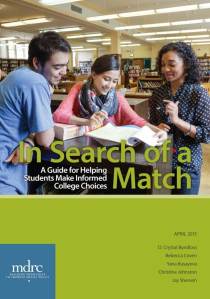A Guide for Helping Students Make Informed College Choices
This guide is designed for counselors, teachers, and advisers who work with high school students from low-income families and students who are the first in their families to pursue a college education. It offers strategies for helping these students identify, consider, and enroll in “match” colleges — that is, selective colleges that are a good fit for students based on their academic profiles, financial considerations, and personal needs. Many of the suggestions in this guide are based on insights and lessons learned from the College Match Program, a pilot program that MDRC codeveloped with several partners and implemented in Chicago and New York City to address the problem of “undermatching,” or what happens when capable high school students enroll in colleges for which they are academically overqualified or do not apply to college at all. The key lessons of the College Match Program, which are reflected in this guide, are that students are willing to apply to selective colleges when:
- They learn about the range of options available to them.
- They engage in the planning process early enough to meet college and financial aid deadlines.
- They receive guidance, support, and encouragement at all stages.
Informed by those key lessons, the guide tracks the many steps in the college search, application, and selection process, suggesting ways to incorporate a match focus at each stage: creating a match culture, identifying match colleges, applying to match colleges, assessing the costs of various college options, selecting a college, and enrolling in college. Because many students question their ability to succeed academically or fit in socially at a selective college, and because they may hesitate to enroll even when they receive good advice and encouragement, the guide offers tips and strategies to help students build the confidence they need to pursue the best college education available to them. Each section also suggests tools and resources in the form of websites and printed materials that counselors, advisers, and students can use, as well as case studies to illustrate the experiences of College Match participants throughout the process.
